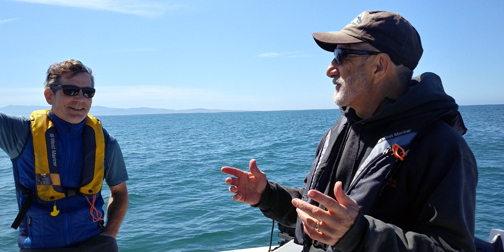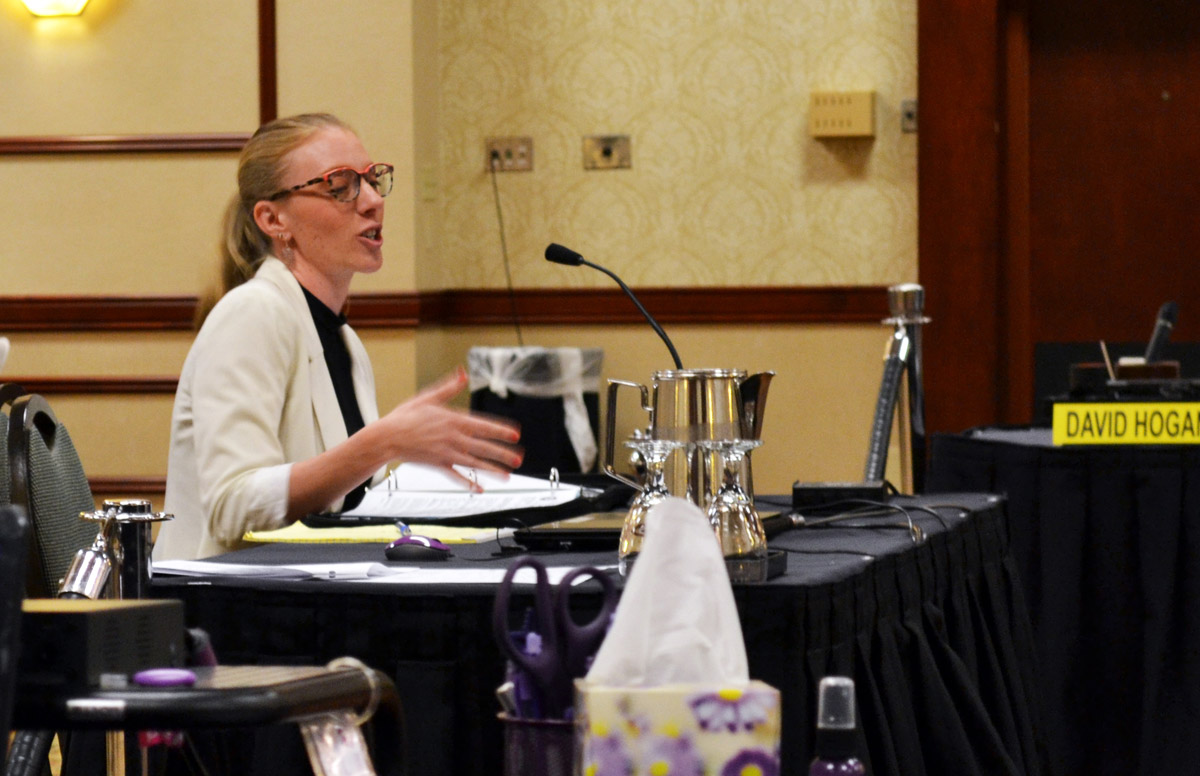Many members of the fishing community and the public don’t have the time or resources to attend Council meetings. Luckily, there are ways to get involved in management without having to leave the comfort of your home.
Marine Resource Education Program
One of the best ways to get involved is by participating in the Marine Resource Education Program, or MREP, a workshop series designed for west coast fishermen interested in building their understanding and involvement in fisheries science and management decisions.
MREP was founded by local New England fishermen in 2001 to provide members of their community with the tools and information to actively and effectively participate in fisheries science and management. Over the next 15 years the program slowly expanded into other regions as other fishermen have expressed a need for that information.
It was developed to equip fishermen with the tools to confidently engage with the tough issues facing their region today. It specifically runs through the fisheries science and management processes, demystifies the acronyms and vocabulary, and exposes fishermen to the ‘how’ of the whole fisheries management process. Additionally, the program provides a neutral setting in which fishermen can meet the people behind agency jobs, ask personally relevant questions, and share important feedback from the fishing community.
The program is offered as a series of two, three-day workshops which build upon each other: a three-day Fishery Science Workshop followed by a three-day Fishery Management Workshop. Presenters are drawn from NMFS Regional Offices and Science Centers, the Fishery Management Councils, research institutions, and the fishing community. Workshops are designed and held as a collaborative effort, with industry moderators keeping the discussion relevant to the fishing community.
Participants leave the workshops prepared to engage confidently in fishery management and to critically evaluate the science affecting their fishery. Learn more.
Learn
The first step to getting involved in the Council process is to learn about it. Learn how the Council system operates; learn about the context of the problem you are interested in. Learn how Council members see things, and why. Learn what terms and acronyms like “CPUE” and “optimum yield” mean. That way you will be more comfortable providing input, and your input will be more valuable.
Some ways to learn:
- Browse this website.
- Explore the fact sheets.
- Get on the mailing list.
- Visit the Council office.
- Read the Council newsletter to learn about recent actions and discussions.
- Read the Council decision summary documents, which summarize decisions made at each Council meeting. (Go to previous meetings and select the meeting you are interested in).
- Follow the Council on Facebook or on Twitter
- Attend a Council, team, or advisory group meeting. Upcoming meetings are listed here, and all are open to the public.
Join a group
Join a group that represents your interests. This will give you a greater voice, more motivation, and a larger pool of knowledge to draw from. There are groups organized around environmental issues, fishing gear types, fisheries, communities, and other interests. There are also groups that cut across interests and gear types. If you can’t find a group, consider joining together with others who have similar interests to form your own group.
Make informed comments
You may comment in person during a Council meeting, or through written public comment via our e-Portal. Your comments will be most effective if they show that you know about the underlying laws and concepts that the Council must follow in managing fisheries. Try to frame your comments and objections in these terms. Whether writing or testifying, make sure that your comments are relevant to whatever the Council is discussing at the moment. Know what stage of the process the Council is in. For example, are there important deadlines approaching? What political pressures are influencing this decision?

Get to know someone
Getting to know someone is one of the best ways to make sure your voice is heard. Get to know your Council representative, other Council members, Committee members, and staff. If possible, get to know your fish and game department’s local port biologists and discuss issues with them. (See the roster on the Council website for lists of Council members and advisory subpanel members).
Talk informally
One of the best ways to interact with the Council is simply to call up a Council member or staff. This provides a more personal way to discuss issues that concern or interest you. When calling, explain who you are, what your question or problem is, and ask for help in understanding what’s going on. Ask for a list of the committees and key council members responsible for your fishery, and ask whom you should call to get more background or advice. You can also talk at meetings and hearings, in the halls during meetings, or at the Council offices. Be sure to attend informal events associated with Council meetings. You may also want to talk with state agency staff and your federal and state representatives.
Attend a meeting
All regular Council meetings and advisory meetings are open to the public. Advisory body and technical committee meetings are generally more informal than full Council meeting, and may be a better opportunity to express your opinions and ideas.
Council meetings are generally held in Portland/Vancouver, Sacramento, Boise, Spokane, Orange County, or Seattle/Tacoma, because these larger cities have airports and plenty of hotel and meeting space.
Because Council meetings are not convenient for many who live in coastal areas, state agencies and other entities sometimes hold public hearings, meetings and workshops in local areas to inform the public and obtain input on proposed fishing regulations. Local residents may contact the head of their state fish and game department to request that a meeting be held in their community. Summaries of the comments made at Council‐sponsored hearings are provided to Council members.
Dates and locations of upcoming meetings are available on the Council website or at the phone number below.

Testify
Members of the commercial and recreational fishery, the environmental community, and the public are encouraged to testify at Council meetings and hearings. This involves speaking in a formal public forum.
At Council meetings, the Council members and staff generally sit in a “U” formation and everyone else sits in chairs at one end of the room. You will have to walk up to a microphone to make your comments. Because of time constraints, all public comment is limited to five minutes for both individuals and representatives of groups.
If comments are supplied to the Council by the briefing book deadline before the meeting date, they are included in the packet of information (briefing book) that is posted online and distributed to each Council member at least a week before the Council meeting.
It is best to be well prepared and as calm as possible when providing testimony. Read up on Council decisions related to your topic of interest and make sure that your comments are organized and relevant. Sign‐up cards are provided at the entrance of the meeting room for people who wish to address the Council. For more tips, see the information sheet titled “Sample Letter & Testimony.”
Comment
All comments submitted through our electronic comment system (and letters or faxes that arrive by the briefing book deadline) are read and considered by the Council. In your comments, explain your connection to the issue, your position, and why you feel the way you do. Whenever you can, be specific about how a proposed rule would affect you. Try to show how your personal interests relate to public or national interests.
You can also write letters to trade magazines like National Fisherman or Pacific Fishing, which many managers read. Since NMFS reviews all Council decisions, it is also effective to write or call the West Coast Region of NMFS.
Serve
Interested citizens may serve on an advisory body. If you are interested in serving, talk to the staff person for the fishery, and get on our mailing list to hear about advisory body vacancies.
Get involved in research efforts

Occasionally, calls go out for vessel owners to charter their vessels for research efforts. While this is not a direct way to get involved in the Council process, it does help create connections with scientists and managers, and it allows vessel owners and scientists to learn more about each others’ methods. It can also provide some extra income. See the NOAA Northwest Fisheries Science Center research site. In addition, exempted fishing permits are a way to test innovative fishing methods or technologies and provide a way for stakeholders to get involved in improving fisheries management.
Will it really make a difference?
Your influence on Council decisions is related to the amount of energy you put into being involved. Involvement can range from signing an online petition to writing an email or letter to serving on an advisory subpanel or team. No matter what level of involvement you choose, your views will have more weight and influence if you learn about the context of the decisions being made, the timeline for the decision making process, and the best ways to communicate with Council members and advisory body members.
As a member of a fisheries association said, “If you want to get involved in fisheries management, you should be willing to go to meetings and become an active participant, be willing to listen to others’ views, and communicate clearly your own ideas.” See the fact sheet “Council Testimony” for more info.
Who to contact
The Council rosters provide contact information for all members of the Council’s advisory subpanels (which include industry representatives), management teams (which are generally made up of scientists), the Council staff, and Council members.
All Council staff can be contacted at 866‐806‐7204 (toll free) or 503‐820‐2280.